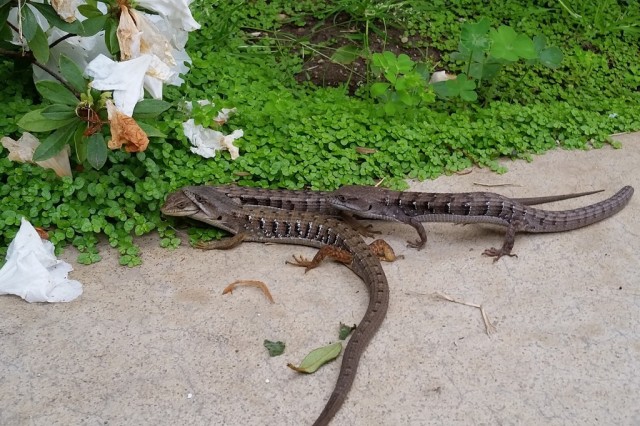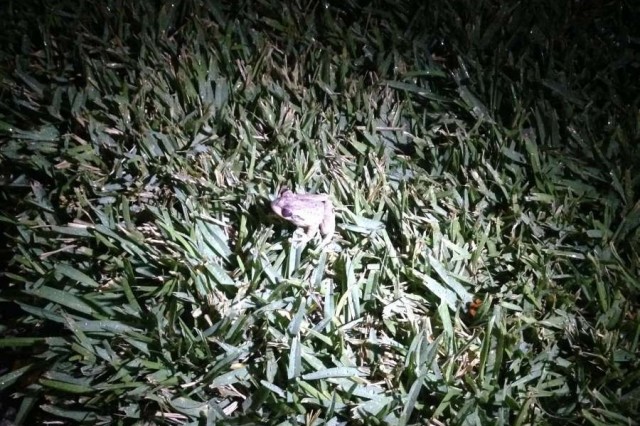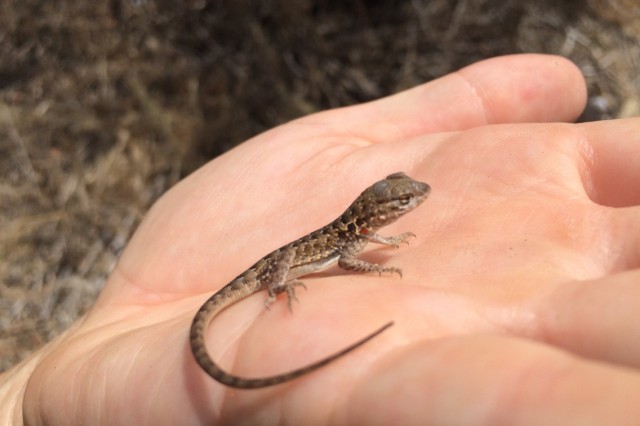Greg Pauly
Dr. Greg Pauly is Curator of Herpetology and Co-director of the Urban Nature Research Center. He studies the natural history, evolution, and conservation of reptiles and amphibians. Since joining the museum in 2012, he has increasingly studied the impacts of urbanization on wildlife. Pauly is an advocate for citizen science and believes partnerships between professional scientists and community members can revolutionize scientific research, allowing professional scientists to ask questions that would otherwise go unanswered. Pauly developed the Reptiles and Amphibians of Southern California (RASCals) citizen science project as a way to compare modern records with historical museum records to understand how species ranges have shifted with increasing urbanization. Pauly was also one of the lead curators on the museum's Nature Lab exhibit. In addition to publishing in academic journals, Pauly co-authored Wild L.A.: Explore the Amazing Nature in and around Los Angeles.
RESEARCH
Phylogenetics, Systematics, and Taxonomy
Molecular phylogenetic approaches are used to test hypotheses regarding biogeography, trait evolution, and species boundaries and relationships. Previous and ongoing research has examined the phylogenetic relationships, systematics, and biogeography of the bufonids (the true toads). Other studies have focused on species delimitation and phylogeographic patterns among closely related taxa or within a particular species. Recent and ongoing research includes studies of phylogeography and species delimitation in amphibians of the western US, comparative biogeographic patterns in salamanders and turtles of the southeastern US, and phylogeographic patterns in Australian freshwater turtles.
Conservation Genetics
Much of the phylogenetic and phylogeographic work described above focuses on species of conservation concern. Here, molecular genetic techniques and morphological analyses are carried out to inform the management and conservation of declining species. Questions addressed include understanding species boundaries, assessing hybridization, and estimating gene flow and migration rates among populations of declining species. Current projects focus on red-legged frogs, Western Toads, and Yosemite Toads in California as well as Alabama Red-bellied Turtles and Flattened Musk Turtles in the southeastern US. The red-legged frog and turtle projects are collaborations with Brad Shaffer and his lab at UCLA and the Alabama Red-bellied turtle work is a collaboration with Jim Godwin at Auburn University.
Advertisement Call Evolution
For most frogs, the primary mating signal is the advertisement call, and the production of these calls is the most energetically demanding activity in which a male frog will ever engage. Plus calling exposes frogs to eavesdropping predators and parasites. Previous and ongoing studies have examined the function of the anuran vocal sac as well as the evolution of the advertisement call in the Western Toad species group in which several species have lost the ability to produce advertisement calls.
Impacts of Urbanization
Habitat loss and alteration due to urbanization presents one of the greatest threats to native species. I have been examining impacts of urbanization on Western Pond Turtles in California since 2000 and on Blotched Watersnakes in Texas since 2006. Much of the pond turtle work focuses on impacts of non-native taxa, particularly the red-eared slider which is the most common turtle in the pet trade, the most commonly introduced turtle world-wide, and now on the IUCN list of "100 of the World's Worst Invasive Alien Species." The watersnake work, a collaboration with Dr. Travis LaDuc at the Texas Memorial Museum, examines movement patterns and population demography along a heavily urbanized stream. New projects in the Los Angeles area include assessing correlates of amphibian and reptile distribution as part of the Lost Lizards of Los Angeles Project and assessing urban turtle diversity.
PUBLICATIONS
Books:
Higgins, L. M., and G. B. Pauly, with J. G. Goldman and C. Hood. 2019. Wild LA: Explore the Amazing Nature in and around Los Angeles. Timber Press, Portland, Oregon. 322 pp.
Peer-reviewed journal articles:
- Georges, A., B. Gruber, G. B. Pauly, D. White, M. Adams, M. J. Young, A. Kilian, X. Zhan, H. B. Shaffer, and P. J. Unmack. 2018. Genome-wide SNP markers breathe new life into phylogeography and species delimitation for the problematic short-necked turtles (Chelidae: Emydura) of eastern Australia. Molecular Ecology 27:5195–5213.
- Liwanag, H. E. M., D. Haro, B. Callejas, G. Labib, and G. B. Pauly. 2018. Thermal tolerance varies with age and sex for the nonnative Italian Wall Lizards (Podarcis siculus) in Southern California. Journal of Thermal Biology 78:263–269.
- Boser, C. L., T. S. Sillett, S. Beissinger, P. Collins, K. R. Faulkner, W. C. Funk, C. K. Ghalambor, M. Guilliams, D. A. Holway, L. Laughrin, G. B. Pauly, J. M. Robertson, R. Shea, and W. Vickers (order of final 10 authors determined alphabetically). 2018. Preparing the historical ecologists of the 22nd century: Priorities for documenting conditions of the terrestrial fauna of Santa Cruz Island, CA. Western North American Naturalist 78:879–887.
- Adams, N. E., M. D. Dean, and G. B. Pauly. 2018. Morphological divergence among populations of Xantusia riversiana, a night lizard endemic to the Channel Islands of California. Copeia 106:550–562.
- Parker, S. S., G. B. Pauly, J. Moore, N. S. Fraga, J. J. Knapp, Z. Principe, B. V. Brown, J. M. Randall, B. S. Cohen, and T. A. Wake. 2018. Adapting the bioblitz to meet conservation needs. Conservation Biology 32:1007–1019. Open access-PDF.
- Putman, B. J., J. P. Drury, D. T. Blumstein, and G. B. Pauly. 2017. Fear no colors? The influence of clothing color on lizard escape behavior. PLoS One 12(8):e0182146. Open access-PDF.
- Spear, D. M., G. B. Pauly, and K. Kaiser. 2017. Citizen science as a tool for augmenting museum collection data from urban areas. Frontiers in Ecology and Evolution 5:86. Open access-PDF.
- Ballard, H. B., L. D. Robinson, A. N. Young, G. B. Pauly, L. M. Higgins, R. F. Johnson, and J. C. Tweddle. 2017. Contributions to conservation outcomes of natural history museum-led citizen science: Examining evidence and next steps. Biological Conservation 208:87–97. Open access-PDF.
- Pauly, G. B., and K. S. Delaney. 2017. Late-season reproduction in Western Toads (Bufo boreas). Bulletin of the Southern California Academy of Sciences 116:147–151.
- Brandvain, Y., G. B. Pauly, M. R. May, and M. Turelli. 2014. Explaining Darwin’s corollary to Haldane’s rule: The role of mitonuclear interactions in asymmetric postzygotic isolation among toads. Genetics 197: 743–747.
- Rojas-Runjaic, F. J. M., P. E. Salerno, J. C. Señaris, and G. B. Pauly. 2013. Terraranans of the Lost World: a new species of Pristimantis (Amphibia, Strabomantidae) from Abakapá-tepui in the Chimantá Massif, Venezuelan Guayana, and additions to the knowledge of P. muchimuk. Zootaxa 3686 (3): 335–355.
- Spinks, P. Q., R. C. Thomson, G. B. Pauly, C. Newman, G. Mount and H. B. Shaffer. 2013. Misleading phylogenetic inferences based on single-exemplar sampling in the turtle genus Pseudemys. Molecular Phylogenetics and Evolution 68:269–281.
- Salerno, P. E., and G. B. Pauly. 2012. Clutch size variation in egg-brooding Stefania. South American Journal of Herpetology 7:47–54.
- Pauly, G. B., S. H. Bennett, J. G. Palis, and H. B. Shaffer. 2012. Conservation and genetics of the Frosted Flatwoods Salamander (Ambystoma cingulatum) on the Atlantic Coastal Plain. Conservation Genetics 13:1–7.
- Davis, D. R., and G. B. Pauly. 2011. Morphological variation among populations of the western slimy salamander on the Edwards Plateau of Central Texas. Copeia 2011:103–112.
- Pauly, G. B., D. M. Hillis, and D. C. Cannatella. 2009. Taxonomic freedom and the role of official lists of species names. Herpetologica 65:115–128.
- Pauly, G. B., S. R. Ron, and L. Lerum. 2008. Molecular and ecological characterization of extralimital populations of red-legged frogs from western North America. Journal of Herpetology 42:668–679.
- Pauly, G. B., O. Piskurek, and H. B. Shaffer. 2007. Phylogeographic concordance in the southeastern United States: The flatwoods salamander, Ambystoma cingulatum, as a test case. Molecular Ecology 16:415–429.
- Pauly, G. B., X. E. Bernal, A. S. Rand, and M. J. Ryan. 2006. The vocal sac increases call rate in the túngara frog, Physalaemus pustulosus. Physiological and Biochemical Zoology 79: 708–719.
- Brown, J. B. and G. B. Pauly. 2005. Increased rates of molecular evolution in an equatorial plant clade: An effect of environment or phylogenetic nonindependence? Evolution 59:238–242.
- Pauly, G. B., D. M. Hillis, and D. C. Cannatella. 2004. The history of a Nearctic colonization: Molecular phylogenetics and biogeography of the Nearctic toads (Bufo). Evolution 58:2517–2535.
- Shaffer, H. B., G. B. Pauly, J. C. Oliver, and P. C. Trenham. 2004. The molecular phylogenetics of endangerment: Cryptic variation and historical phylogeography of the California Tiger Salamander Ambystoma californiense. Molecular Ecology 13:3033–3049.
- Shaffer, H. B., G. Fellers, S. R. Voss, J. C. Oliver, and G. B. Pauly. 2004. Species boundaries, phylogeography, and conservation genetics of the red-legged frog (Rana aurora/draytonii) complex. Molecular Ecology 13:2667–2677.
- Spinks, P. Q., G. B. Pauly, J. J. Crayon, and H. B. Shaffer. 2003. Survival of the western pond turtle, Emys marmorata, in an urban California environment. Biological Conservation 113:257–267.
Natural History Notes (short, peer-reviewed notes):
*community scientist co-author
- Pauly, G. B., and P. D. Gavit*. 2019. Geographic distribution: USA, California, Los Angeles County: Trachylepis quinquetaeniata. Herpetological Review 50:103–104.
- Altig, R., G. B. Pauly, and R. E. Espinoza. 2016. Geographic distribution: USA, Mississippi, Oktibbeha County: Hemidactylus turcicus. Herpetological Review 47:628.
- Pauly, G. B., and D. B. Borthwick*. 2015. Geographic distribution: USA, California, Los Angeles County: Anolis carolinensis. Herpetological Review 46:567.
- Pauly, G. B., G. S. Yoshida*, and R. Worrell*. 2015. Geographic distribution: USA, California: Hemidactylus garnotii. Herpetological Review 46:569.
- Pauly, G. B., A. Wells*, M. H. Espinoza, T. A. Wake, and R. E. Espinoza. 2015. Geographic distribution: USA, California, Orange County: Hemidactylus turcicus. Herpetological Review 46:59.
- Larson, G. C., C. Huntley*, G. B. Pauly, T. Wolfmeyer, B. Singh, and R. E. Espinoza. 2015.Geographic distribution: USA, California, Ventura County: Hemidactylus turcicus. Herpetological Review 46:59.
- Pauly, G. B. 2012. Freeze tolerance of the eastern fence lizard, Sceloporus undulatus. Southwestern Naturalist 57:472–473.
- Pauly, G. B. 2012. New county records for the rolling plains of north Texas. Herpetological Review 43:115.
- Pauly, G. B. 2010. Geographic distribution. Graptemys geographica. Herpetological Review 41:509.
- Pauly, G. B. 2010. Comments on the proposed conservation of usage of Testudo giganteaSchweigger, 1812 (currently Geochelone (Aldabrachelys) gigantea) (Reptilia, Testudines). Bulletin of Zoological Nomenclature 67:78. Not peer-reviewed.
- Baird, A. B., G. B. Pauly, D. W. Hall, and T. J. LaDuc. 2009. Records of the porcupine (Erethizon dorsatum) from the eastern margins of the Edwards Plateau of Texas. Texas Journal of Science 61:65–67.
- Pauly, G. B. and T. J. LaDuc. 2009. Bogertophis subocularis (Trans-Pecos Ratsnake). Arboreality. Herpetological Review 40:93.
- Pauly, G. B. and T. J. LaDuc. 2009. Nerodia erythrogaster (Yellow-bellied Watersnake). Diet. Herpetological Review 40:100.
- Oliver, J. C., K. L. Prudic, and G. B. Pauly. 2007. Parasitism rates in larval Lycaena xanthoides (Godart) (Lepidoptera: Lycaenidae) and a new host record for Cotesia theclae(Riley) (Hymenoptera: Braconidae). The Pan-Pacific Entomologist 83:262–264.
- Pauly, G. B., X. Bernal, and R. Taylor. 2005. Scinax ruber (Red Snouted Treefrog). Arboreality and parachuting. Herpetological Review 36:308–309.
- Seabury, R. E., D. W. Hall, and G. B. Pauly. 2005. Geographic distribution. Bufo woodhousii. Herpetological Review 36:198.
- Pauly, G. B. and J. M. Brown. 2005. Geographic distribution. Storeria dekayi texana. Herpetological Review 36:84.
- Pauly, G. B. and M. F. Benard. 2002. Crotalus viridis oreganus (Northern Pacific Rattlesnake). Costs of feeding. Herpetological Review 33:56–57.


